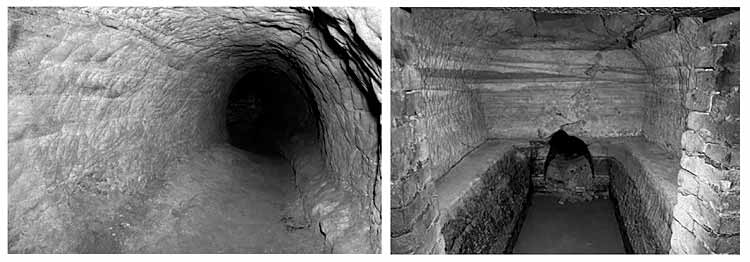Articles from the Thoroton Society Newsletter
New work on Nottingham's caves
By Dr Chris King
Nottingham is well known for its hundreds of historic caves, all carved into the soft sandstone rock on which the town and castle are built. The earliest reference to an association between Nottingham and caves goes back to Asser’s Life of King Alfred, written in the late 9th century, where the town is called Tig Guocobauc, translated as ‘house of caves’. While no Anglo-Saxon caves have been clearly identified in the city, it is known that many caves date back to the medieval period, between the twelfth and fifteenth centuries. Caves underneath buildings could be used for a wide range of purposes; storage being the most obvious function, but they were also used as workshops. Several of the caves contain medieval tanning pits, including the caves dug into the cliff-face beneath the former Broadmarsh shopping centre; others were specialist malt-kiln caves for malting barley for beer. In the post medieval period caves were both functional and decorative. They were used as ale cellars, butcher’s workshops, and stables. Some caves, such as the system beneath Peel Street, originated as sand mines, with the sand being used for glass manufacturing and other industries. Other caves were carved out as grottoes or entertaining spaces in the gardens of the town’s wealthy elite, such as the caves in the gardens of houses in the Park Estate carved with sculptural panels of classical or biblical scenes. Houses were built along the cliff faces around the town with caves forming part of residential spaces. In the Second World War, many of Nottingham’s caves served a vital purpose as air raid shelters. A huge amount of work has been done on the caves over many decades, with archaeological investigation and historical research (such as Andrew Hamilton’s book Nottingham's Caves) more recently extended by efforts to record the caves using laser scanning technology, undertaken by Trent and Peak Archaeology (now York Archaeology) and available as the Caves of Nottingham Regeneration Project.
Over the past year, a project led by the University of Nottingham (led by Dr Chris King in Archaeology and Dr Richard Goddard in History) has aimed to bring together this wealth of material so that it can be more easily seen as a whole. The project has as its focus the caves underneath the Broadmarsh centre, which are operated as a visitor attraction by the National Justice Museum, and the hope is to ensure that the history and heritage of the Broadmarsh zone and its caves are incorporated in the ongoing redevelopment of the site and its presentation to the public, so that we can engage wider audiences with Nottingham’s unique legacy of historic caves.
 Two photographs of part of the cave system beneath Wollaton Hall, including the water cistern known as '‘the Admirals Bath' (University of Nottingham ).
Two photographs of part of the cave system beneath Wollaton Hall, including the water cistern known as '‘the Admirals Bath' (University of Nottingham ).As part of this research, Dr Goddard has completed some in-depth work in the Nottingham archives focused on the medieval Borough Court rolls, to identify references to caves and the kinds of activities and people associated with them.
Caves are usually referred to as vaults or cellars, seen as functional assets within the wider built environment of the town. For example, in 1363 William Brigaunt and his wife Isolda enrolled a charter with the court, recording their purchase from William Barbour and Joan his wife of ‘a cottage with curtilage and an adjacent cellar below the rock (sub rupe) in Broad Marsh (in magno marisco)’ [CA 1272/6d].
Cave cellars were used for the storage of wine, beer and hay, but they also housed wells, and there are also frequent complaints of people dumping refuse and dung inside caves. These records are rich and varied, and clearly have a great deal of potential to reveal unprecedented insights into life in the medieval town.
To find out more about the University’s project and ongoing work on the caves, please visit the project website for:
‘City of Caves: Regenerating the Heart of Nottingham through Hidden Heritage’ at the Department of Classics and Archaeology: https://www.nottingham.ac.uk/humanities/departments/classics-a nd-archaeology/index.aspx
Dr Chris King
< Previous